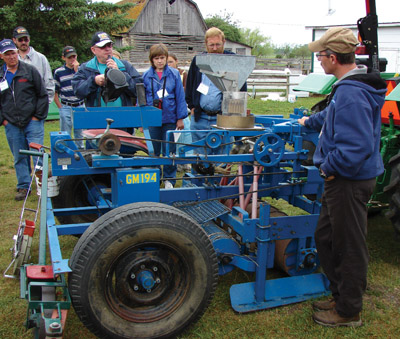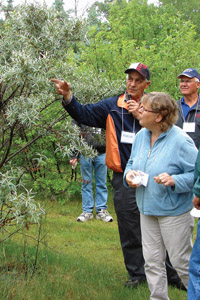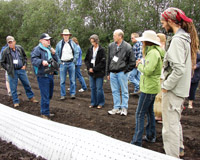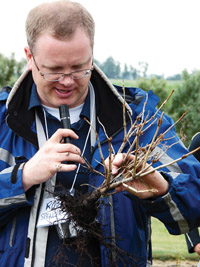
Features
Production
Research
Sharing knowledge in Alberta
Veteran producers share experiences with field day participants
September 16, 2010 By Tony Kryzanowski
Participants in a recent fruit and vegetable field day hosted by the
Alberta Farm Fresh Producers Association came away with a lot of fresh
ideas based on the wisdom three veteran commercial producers shared
with them regarding equipment, production and marketing, despite it
being their busiest time of year.
Participants in a recent fruit and vegetable field day hosted by the Alberta Farm Fresh Producers Association came away with a lot of fresh ideas based on the wisdom three veteran commercial producers shared with them regarding equipment, production and marketing, despite it being their busiest time of year.
 |
|
| One of the main attractions during the recent fruit and vegetable field day hosted by the Alberta Farm Fresh Producers Association was the opportunity to learn about equipment availability and use. Advertisement
|
All three north-central Alberta producers are selling some or all of their berry, bedding plant and vegetable crops directly to consumers at farmersmarkets.
Association manager, Don Gregorwich, says there is a need for this type of education, given the “morphing” and growth that is occurring in the industry. What was once an industry dominated by u-picks is now evolving and expanding into farm stores, direct marketing to consumers through farmers markets, as well as direct marketing to restaurants and retail stores. The variety of crops being grown and marketed by members is also expanding. Membership has grown over the past five years from 120 to 180 members.
The underlying message from the seasoned producers visited on the field day was that there is money to be made in marketing farm fresh fruit, vegetables, and value-added products directly to consumers. Erdmann’s Gardens and Greenhouses co-owner, Rony Erdmann, mentioned that some customers have even thanked them for doing it.

|
|
| EMJAY Prairie Berries co-owner Marvin Hrudey produces jam from the berries produced by these sea buckthorn bushes. Birds tend not to like these berries.
|
In terms of equipment availability, all three emphasized that there is plenty of purpose-built equipment available, often second hand at deeply discounted prices, to meet the needs of start-up farms and those wanting to grow their businesses.
“I was at an auction recently where they were begging me to buy a saskatoon picker for $500,” says EMJAY Prairie Berries co-owner, Marvin Hrudey. He owns the business with his wife, Judy. “It was probably worth $5,000 brand new.” The business is located north of Andrew, Alta., and is focused primarily on berries and value-added products such as jam.
EMJAY Prairie Berries has been actively involved with researchers at the University of Saskatchewan on the university’s haskap breeding program. Haskap is a variety of blue honeysuckle, a fruit-bearing shrub that is native to Canada. Its roots and blossoms are extremely resilient to cold weather and fruit production starts in June. There’s been plenty of hype lately concerning haskap’s potential as a cash crop in Canada. Given EMJAY’s experience with the fruit, it appears that haskap as a commercial crop is for real, and offers an opportunity for additional cash flow early in the season before other more traditional crops are ready for harvesting.
“This is our pride and joy,” Hrudey announced, as tour participants reached his rows of haskap in an orchard that featured a manicured lawn between each row of various berry shrubs, and plastic ground cover around each shrub to discourage weed growth and suckering.
“There’s a great future in it (haskap),” says Hrudey, “and there is also very good public acceptance.” They market both fresh berries and jam at area farmers markets.
Hrudey has experienced a few issues with his haskap varieties. He has not yet found an easy way to pick the berries and they do not tolerate being handled a lot. Also, birds such as waxwings love feeding on them. Otherwise, he says fruit production per shrub is excellent and the size of individual berries of some varieties is outstanding.
 |
|
| Linda’s Market Gardens co-owner Don Christensen explains the principles behind their mini-greenhouses, which are used to produce higher volumes of cucumbers more quickly.
|
Hrudey and his wife are retired and consider themselves more as operators of a research and development orchard than as a commercial business. Based on his experimentation so far, Hrudey says he believes the berry crops in climates similar to north-central Alberta with the greatest commercial potential are haskap, saskatoons, and sea buckthorn. They also sell sea buckthorn berry jam, and birds don’t seem to like the berries on those shrubs.
In terms of equipment availability, Linda’s Market Gardens co-owner, Don Christensen, spoke about finding a second hand mechanical bagger in Georgia, and negotiating a deal with a local trucker to bring the unit back to Alberta as another example of specialized equipment availability at a reasonable cost for those willing to take the time to search for it. The trucker was transporting goods to the American South on a regular basis and had plenty of empty cargo space to bring the bagger back on the return trip. Christensen also showcased some of the business’s newer equipment that they have purchased for such challenging applications as sowing small seeds for their cucumber crop. They have developed a “mini-greenhouse” method for growing their cucumbers that results in triple the production volume and cucumbers ready for picking typically three weeks sooner than other growers. Christensen says that their method can easily be replicated and is not time consuming once growers become familiar with it. Installing the mini-greenhouses over the plants is also partially mechanized.
Linda’s Market Gardens has two locations near Smoky Lake, Alta., and is owned by Linda and Don Christensen. One location is on their farm and the second location is their Farm Store located on Highway 28, across the road from Smoky Lake. Don acknowledged that Linda’s decision to purchase some property along a major highway to catch the attention of locals, travellers, and vacationers has had a major impact on the business. He estimates that the move to a more visible location increased their business fivefold almost immediately.
 |
|
| Alberta Agriculture commercial horticultural specialist Robert Spencer was a valued resource available to participants in a recent field day to fruit and vegetable growers hosted by the Alberta Farm Fresh Producers Association.
|
Not only did the veteran producers share their knowledge concerning the acquisition and use of equipment, but they also spoke glowingly about their participation in the temporary foreign worker program. Their participation in the program makes it possible for them to bring experienced laborers from Mexico to work in jobs often difficult to fill locally. Both Linda’s Market Gardens and Erdmann’s Gardens and Greenhouses have participated in the program for about five years. Erdmann’s has been in business for nearly three decades and is located north of Edmonton near Vimy. They are very active in marketing both bedding plant and vegetable products at farmers’ markets. While they produce many vegetables, their main crops are potatoes, cabbage and peas. The business is owned by Rony and Wendy Erdmann. Both the Erdmanns and the Christensens say they have witnessed significant improvement in the quality of their crop management and production since employing temporary Mexican workers, many of whom return each season.
Erdmann’s has six temporary workers and Linda’s Market Gardens has four workers.
“They like to stay busy,” says Rony Erdmann. He adds that he really has to stay on his toes to plan at least two days in advance to make sure there is enough work lined up to keep the workers busy because they catch up in a hurry. The high quality of work in areas such as weed control at the market garden was obvious to field day participants and the speed at which the team of four workers moved was remarkable to many who watched them in action.
The Alberta Farm Fresh Producers Association hosted two field days this summer, one in north-central Alberta and one in the south-central area.
Print this page